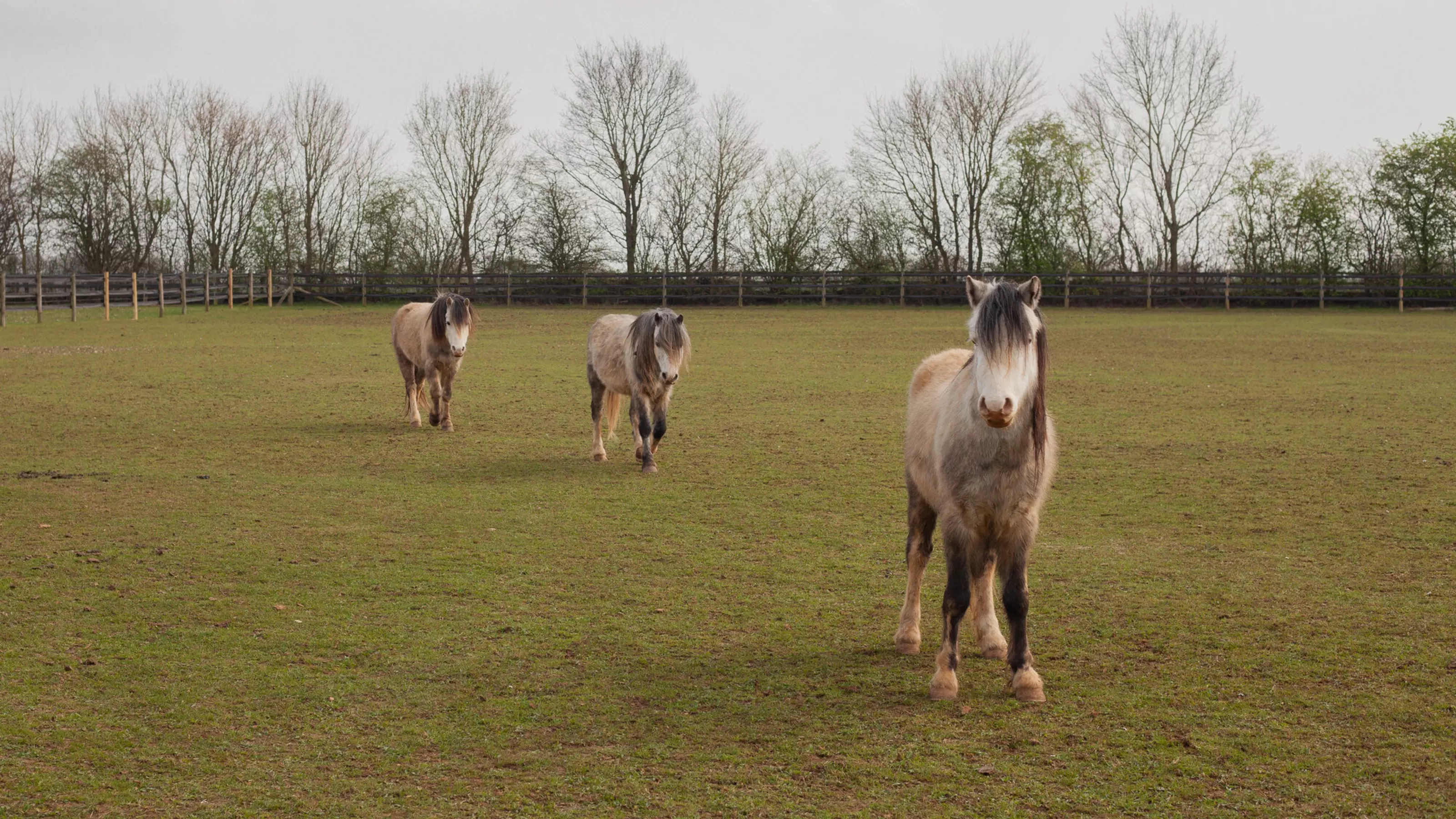
Pasture management
If you keep horses on your own land, there are things you'll need to do to keep the pasture sustainable and productive.
One way to ensure your land is suitable for horses is by putting in place a good pasture management plan. Not only does this benefit your pasture, but it also maintains your horse's health and wellbeing by allowing them to browse and display more natural behaviours.
Having a good pasture management plan can prevent your horse's field from becoming ‘horse sick’. Land that is overgrazed, rough, worm or weed infested can all have a negative impact on your horse’s health.
Actively managing your land also means that you can grow types of grasses that are more beneficial to your horse, and are more cost effective over time.
Poo picking and worm control
Removing your horse’s droppings from the field is an essential part of good field maintenance. Horses shed worm eggs in their droppings which then develop into larvae. In cooler weather (under 25 degrees) larvae can exist in the grass for up to nine months. Horses will ingest the larvae as they graze, therefore becoming re-infected and continuing the worm life cycle.
Worm eggs laid in droppings hatch within four to five days. Research suggests that poo picking twice a week is sufficient to significantly reduce infective larvae on the pasture. But the best way to stop this worm life cycle and reduce your horse’s worm burden is to remove the droppings as soon as possible.
When droppings build up in the field, the grass beneath can also die off, creating rough patches of poor quality grazing that horses do not like to eat. Over time, this contributes to the grazing becoming ‘horse sick’ and lacking nutritional value and suitability for the horse.
Since worm eggs survive for longer in shelters than on open pasture, field shelters should also be poo picked regularly. If you're providing supplementary feed you can give this in a container to prevent it from being contaminated. Any hay dragged through bedding in the shelter should not be re-fed.
Tip
Regular faecal worm egg counts will help you to monitor the amount of worms present in your horse. You can visit our horse worming page to find out more about targeted worming programmes.
Do not harrow your fields to remove or spread droppings. This will only spread the worm eggs in the droppings around the field. Research has shown that this is only affective when temperature is above 35 degrees and therefore hot enough to kill the worm eggs and larvae.
Fresh dung is, however, also essential for dung beetles, who play an important role in managing animal waste naturally. Dung beetles prefer fresh dung up to 48 hours old – to encourage dung beetle activity, you can leave some of the freshest piles on the pasture and clear them after three days.
Daily care for your pasture
There are various checks on your pasture that should be done on a regular basis:
Check list:
- Once per day – Check that boundary fencing is safe and gates are secure, check for acorns and sycamore seeds in autumn and spring, poo pick , check water supply is clean and functioning
- Once per week – Check that boundary fencing is safe (particularly hedges that may become thinner during the colder season) and gates are secure, check for litter, monitor holes in the ground, check for and remove poisonous plants and broken or loose tree branches
- Once per month – Fence off rabbit or badger sets (these are protected by law) , fence off oak or sycamore trees in autumn and spring , check for any damaged or falling branches
Seasonal care for your pasture
There are some tasks that you'll need to do at certain times of the year to keep your pasture in healthy condition. This is usually because of weather conditions affecting the paddock.
Many of these tasks can be done by yourself however it’s best to discuss your options with a professional contractor or specialist who will be able to use the correct equipment. Alongside tasks such as harrowing and re-seeding, be sure to include resting and rotating in your paddock management plan.
- Spring – Carry out soil analysis, remove weeds, harrow, fertilise, reseed and roll boggy areas from winter.
- Summer – Remove weeds, harrow and roll
- Autumn – Carry out soil analysis, monitor acorn and sycamore seeds if necessary
- Winter – Rest paddocks as much as possible, and consider fertilisers for Spring
Harrowing
Harrowing the pasture is useful for removing dead vegetation and improving air circulation in the soil, allowing for new healthy grass growth. It can also prepare the soil for new seeds. Be aware that when dead plants are removed, it can leave bare areas of soil to be infested by weeds.
Be careful when harrowing light soil (such as sandy or chalky soil) as grass is more easily uprooted and soil can be eroded.
Tip
Harrowing is best done during warm weather. When the ground is wet, harrowing can churn up the soil and damage the grazing.
Seeding
Overseeding is the process of adding grass seeds to existing areas of grass. Reseeding areas of thin and damaged grass with appropriate grass seeds helps improve the quality and sustainability of the pasture. It’s best done during warm temperatures, just before rain – late August to September is ideal for encouraging the seeds to germinate quickly. You can also sow new seeds in early spring.
There are many types of grass seeds on the market which can help to improve your pasture and also provide a wide variety of grass species and herbs. This will benefit both your horse and their environment. When choosing a seed mix, make sure to choose one containing low energy grasses and herbs. If in doubt, it’s a good idea to always seek advice from an expert.
Having a variety of suitable grasses and herbs for your soil type can help to strengthen the pasture. Alongside resting your paddocks, this can prevent poaching.
Note
Horses should be kept off freshly seeded pastures for around eight weeks after sowing.
Fertilising
Before you fertilise your paddock, you should test the soil to find out the pH level along with any deficiencies. Readings can be taken regularly between February to April and September to December. Taking multiple readings will also give you a better understanding of the soil and will help you to choose the right fertiliser.
There are a range of commercially available fertilisers that encourage grass growth. They should always be applied with caution – incorrect or unnecessary fertilising can cause severe digestive disorders in horses.
Natural fertilisers (such as well-rotted farmyard manure) are usually best for use on horse pasture – a generous application once every couple of years should be enough. Horse manure should not be used as a fertiliser on horse pastures.
Rolling
Rolling helps to press down turf that may have become cut up and poached by horses’ hooves. Rolling firms up the pasture, making it less susceptible to future poaching, and helps discourage weeds that prefer to germinate in loose soil.
Care must be taken when rolling heavy soils, such as clay, as the ground can become too compacted and natural soil drainage is then reduced. If your paddock is on heavy soil, you may want to include aerating in your paddock management plan, instead of rolling.
Weed control
The paddock should be checked regularly for weeds and any poisonous plants. Weeds can spread quickly, reducing the quality of the grazing area. Those that are poisonous can be harmful to grazing horses.
Weeds should not be allowed to grow in fields where horses graze, nor in fields used for hay production. Different plants will need different methods of removal depending on how much is found in the field.
Ragwort is a common paddock weed that is harmful for horses – you are required by law to remove it from your field. The best way to control ragwort is to pull it up with its roots, then remove and burn the plants. You can treat ragwort with a herbicide in the rosette stage if your horses are kept off the grazing for the recommended time.
Important
Gloves should always be worn when handling ragwort as the toxins are harmful to people and can cause irritation.
Page details
Published
• 16 October 2023
Next review
• 16 October 2026





